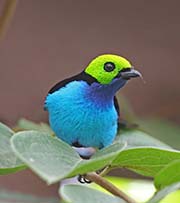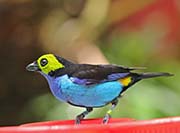Paradise Tanager - Tangara chilensis
| Length | |
| Weight | |
| Clutch Size | |
| Chicks at birth | |
| IUCN Conservation Status | |
Continents: |
There are four subspecies of Paradise Tanagers found in South America. Their body is black, with blue underparts, a light-green head and a yellow and red rump that is all red in some subspecies. The beak, legs and feet are black. Sexes are similar.
Diet: Forages primarily at the upper canopy of fruiting trees. Hops along bare branches, looking underneath for insects and larvae.
Courtship: Paradise Tanagers are considered to be gregarious birds and are found in groups of 5-20 and can often be found in mixed species flocks.
Nesting: 2-4 whitish eggs marked with purplish red spots are laid in a cup-shaped nest.
Habitat and Range: Paradise Tanagers are found throughout most of the South American Amazon basin and prefer low-lying forests and second-growth woodland at the forest edge, shaded plantations, and clearings with scattered trees.
Vocalization: Paradise Tanagers produce a variety of songs including a sharp, moderate-pitched 'chak', a thin rising 'zeee' and a high 'sizit'. In the morning, the Paradise Tanager gives a 'Dawn Song', which is a repeated 'chak-zeet every two seconds.
Plumage/Molt No alternate plumage (annual molt).
Migration: Non-migratory.
Tongue/feet: Feet and legs are black.
Bibliography:
- http://en.wikipedia.org The Free Encyclopedia, Accessed July, 2013
- Isler, Morton L. and Isler, Phyllis R., The Tanagers: Natural History, distribution, and Identification,Smithsonian Institution Press, Washington D.C., 1987, Accessed July, 2013
- http://neotropical.birds.cornell.edu/portal/home The Cornell Lab of Ornithoogy Neotropical Birds, Accessed July, 2013





